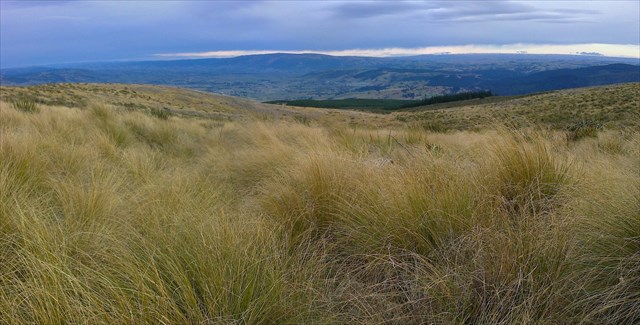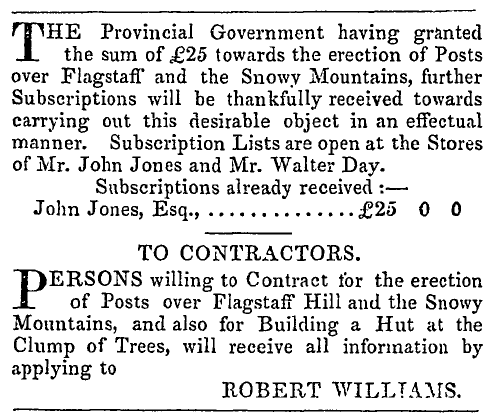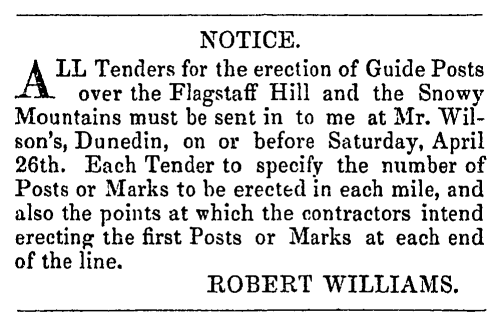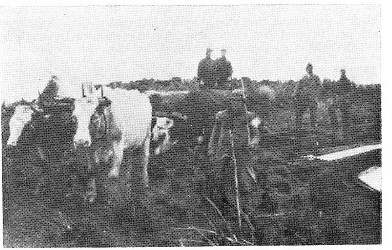Where Bullocks Passed (Dunedin, Otago) Traditional Geocache
Where Bullocks Passed (Dunedin, Otago)
-
Difficulty:
-

-
Terrain:
-

Size:  (small)
(small)
Please note Use of geocaching.com services is subject to the terms and conditions
in our disclaimer.
Come and see where bullocks once passed on Flagstaff. You’ll find a 1.2 litre snaplock deposited in the deep 19th century bullock cart ruts on Otago's first road between Dunedin and Waikouaiti.
You will have to cope with uneven ground and the occasional stab from a wild spaniard (speargrass, aciphylla) - and be careful not to fall into the ruts when you reach them! You can trace the course of the ruts through the saddle midway between Flagstaff trig and Flagstaff Hill cache, using the WAMS map aerial photo.

A map of the road's route is attached as a photo, and relevant excerpts from books on local history are included as log notes at the bottom of the page.
For the first 15 years of Dunedin’s existence, this bush-free “Mountain Track” was the only road north. It was particularly important as the stock route by which Johnny Jones supplied the early settlers with food from his farms at Cherry Farm and Matanaka. Travellers wanting to use the road would often wait for one of Johnny Jones’ frequent trips to take advantage of his guidance. In 1857 David Hutcheson began carrying mails north by the mountain track in a fortnightly service, using a horse and packhorse, being paid £200 a year.
William Cutten wrote in 1852 that the track “over the mountains … is a very pleasant ride in fine warm weather”. However, it was lonely and if the mist rolled in (as it often did - and still does) the journey might prove dangerous. Many people lost their way. The Rev. John Christie wrote in 1880 of several skeletons which had been found along the route (see excerpt as log note below).
In September 1850, after a person died on the Mountain Track, Peter Crow (a butcher) announced in the Otago News that subscriptions would be received in his shop in High Street for the purpose of raising money sufficient to erect flag staffs through the Snowy Mountains, thereby preventing further accidents and loss of life. It was also proposed to erect a half-way hut as a shelter for travellers benighted in bad weather. These flagstaffs gave “Flagstaff Hill” its name.
However, in May 1852 carpenter Thomas Tandy disappeared without trace. The Otago Witness 5 June 1852 reported that a considerable sum of money had been collected to erect guide posts, but the work done was “disgraceful” and “of no avail”.
In 1856 the Provincial Council unanimously voted £25 pounds to erect guiding posts over Flagstaff Otago Witness 15 March 1856. Johnny Jones immediately matched this contribution. Advertisements were placed asking for further subscriptions and tenders for erecting guideposts and building a shelter hut Otago Witness 19 April 1856 advt tender. (Walter Day was an ironmonger).


Dr Robert Williams (Coroner and member of the Provincial Council) received tenders and the work was contracted out to David Millar at a price of £88. Six-foot-high turf mounds between Flagstaff and The Clump and a totara hut were erected. There was a disagreement over the standard of work and, come October, Dr Williams took Mr Millar to the Magistrate’s Court claiming inadequate work (Johnny Jones had not yet paid his subscription to the fund, either). The case was dismissed with costs Otago Witness 25 October 1856. This led to an exchange of letters in the newspaper:
• Letter to Editor from Mr Millar: Dr Williams has still not paid the £68 still owing Otago Witness 1 November 1856.
• Editorial: an impertinent letter received; not much public interest; this is the second time project has been attempted and failed due to unsatisfactory work; public money wasted Otago Witness 1 November 1856.
• Letter to Editor from Dr Williams: Has not paid because work has not been completed to his satisfaction Otago Witness 15 November 1856.
• Letter to Editor from Mr Millar: Public are interested in breach of contract; arbiters decided work was up to standard; Dr Williams still refuses to pay; Dr Williams is taking advantage of a poor man unable to take the matter to the Wellington Court. Otago Witness 22 November 1856.
In 1857 Mr Millar did take Dr Williams to court. The jury found in his favour, and he was awarded the £68 owed plus costs Otago Witness 8 August 1857.
An unknown correspondent travelling north in 1862 was enjoined never to lose sight of the poles. Luckily his companion knew the route Otago Witness 15 March 1862
By 1864 the route was being referred to as “the old mountain track”; newly imported cattle driven to Johnny Jones’ property by that route were found to have pleuro-pneumonia Otago Witness 13 January 1864. When Pakeha rambled over to Blueskin in 1871, the stockyards were still standing at the drovers' usual overnight stop at The Clump, but there seems to have been no other evidence that this was once a well-used track Otago Witness 25 March 1871.
Now, about those bullocks...
 The first bullock team was brought to Marsden’s Keri Keri mission station in 1820 in the naval ship Dromedary. On Wednesday 3 May 1820 the Rev John Gare Butler ploughed a wheat field with the team of six bullocks - the first ploughing in New Zealand. He wrote in his diary: “I trust that this auspicious day will be remembered with gratitude and its anniversary kept by ages yet unknown.” Later that year the Dromedary borrowed the bullock team to haul kauri spars for ships’ rigging at the Kaeo River in Whangaroa Harbour, cutting a road through the bush. This was the first use of bullocks in the timber industry and the first road for wheeled vehicles in New Zealand. (The Pilot newsletter June 2010 pdf).
The first bullock team was brought to Marsden’s Keri Keri mission station in 1820 in the naval ship Dromedary. On Wednesday 3 May 1820 the Rev John Gare Butler ploughed a wheat field with the team of six bullocks - the first ploughing in New Zealand. He wrote in his diary: “I trust that this auspicious day will be remembered with gratitude and its anniversary kept by ages yet unknown.” Later that year the Dromedary borrowed the bullock team to haul kauri spars for ships’ rigging at the Kaeo River in Whangaroa Harbour, cutting a road through the bush. This was the first use of bullocks in the timber industry and the first road for wheeled vehicles in New Zealand. (The Pilot newsletter June 2010 pdf).
 Bullock carts or sledges provided the usual heavy transport in early New Zealand. Bullocks could be either castrated bulls or cows. They were slower than horses, moving at a steady 3 km/hour, but were stronger and more dependable, hardier, cheaper to feed, usually did not need shoeing and were cheaper than horses. The first edition of the Otago News in 1848 listed the price of a mare as £20 to £30 and a pair of working bullocks as £30 to £40. (By comparison, wages per 10 hour day were: Mechanics, 5/- to 7/- ; labourers, 3/- to 4/-)
Bullock carts or sledges provided the usual heavy transport in early New Zealand. Bullocks could be either castrated bulls or cows. They were slower than horses, moving at a steady 3 km/hour, but were stronger and more dependable, hardier, cheaper to feed, usually did not need shoeing and were cheaper than horses. The first edition of the Otago News in 1848 listed the price of a mare as £20 to £30 and a pair of working bullocks as £30 to £40. (By comparison, wages per 10 hour day were: Mechanics, 5/- to 7/- ; labourers, 3/- to 4/-)
Waitati dairy farmer Bill Harris had the last working bullock team in Otago. This photo shows construction material being sledged into OTMC Green Hut site in January 1933. The eight-bullock team was still being used for hauling logs in 1939, and they walked in the 1948 Dunedin Centennial procession.
Most bullocks in early New Zealand were Shorthorns (then known as Durhams), a versatile breed useful for milk and beef as well as haulage. Bullocks were broken in around three years old and worked to about fourteen year old, and afterwards could be fattened for meat and leather.
The bullocks were yoked in pairs, always in the same order with the quieter ones on the near side (left) and the wilder ones on the off side (right). Bullocks were named and taught to respond to the bullocky’s calls and the crack of his whip.
Read in the log note below how Macleod Orbell, a 1849 Waikouaiti settler, trained bullocks to the yoke.
• Jerningham Wakefield wrote about a foul-mouthed but cunning bullocky in 1840’s Wellington: Frequent Fines.
• Joan Druett celebrates: The Patient Bullock.
• Jack Andrews tells a joke about creative bullock naming: Beefing about Bullocks.
• Jeff Newport recounts the story of a bullock who rolled over to be shod: Bullock Teams.
• The 1936 Railways Magazine noted the advantages of bullocks: The Old Reliable.
And more details on early routes north...
When Dunedin was settled in 1848, communication with Waikouaiti was difficult. Sea travel was popular, but expensive and irregular and in stormy weather it wasn’t possible to land at Waikouaiti.
The Maori foot track was naturally centred on the kaik at Otakou, rather than Otepoti, and it was narrow and easily lost. It went from Aramoana and (apart from going over Mopanui saddle between Orokonui and Purakaunui) mainly followed the coast to Waikouaiti.
In 1844 surveyor Frederick Tuckett had cut a track from Waitati over Mihiwaka to Port Chalmers, but this was very muddy indeed and impossible for riding.
In 1859 work began on a track over the Kilmog between Waikouaiti and Evansdale.
The Road Board instructed the Engineer to find a suitable line for the great north road from Blueskin to Dunedin so as to avoid Flagstaff Otago Witness 6 February 1858 and by 1860 there was a 4 foot wide bridle track from North East Valley to Blueskin.
In 1863 the road from Dunedin to Waikouaiti opened, and in 1864 the Waikouaiti River bridge was completed.
Additional Hints
(No hints available.)